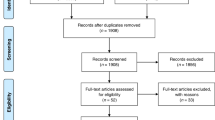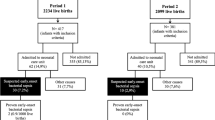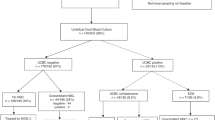Abstract
Objective:
The significance of cord blood neutropenia as a screening tool for early-onset sepsis (EOS) is unclear. The objectives were to define reference values for cord blood neutrophil count and to determine the sensitivity and positive likelihood ratio of cord neutropenia for the detection of EOS.
Study Design:
This retrospective observational cohort study included all mother–infant pairs with deliveries between 2009 and 2014 for whom cord neutrophil counts were routinely done. EOS cases were identified by interrogation of electronic charts. Maternal and perinatal factors were assessed to determine reference values of cord neutrophil. The diagnostic value of neutropenia for detecting EOS was assessed. A nested case–control design was used to measure the value of neutropenia in the detection of EOS in comparison with other risk factors.
Results:
A total of 8,590 mother–infant pairs were included. We identified 84 sepsis cases. The neutrophil count was strongly associated with gestational age. Neutropenia adjusted for gestational age was strongly associated with EOS and had good specificity but poor sensitivity. The addition of neutropenia to other EOS risk factors increased sensitivity without decreasing specificity.
Conclusion:
Cord blood neutropenia was significantly associated with EOS and the addition of cord neutropenia to current EOS risk factors increased the detection rate of EOS.
This is a preview of subscription content, access via your institution
Access options
Subscribe to this journal
Receive 12 print issues and online access
$259.00 per year
only $21.58 per issue
Buy this article
- Purchase on Springer Link
- Instant access to full article PDF
Prices may be subject to local taxes which are calculated during checkout


Similar content being viewed by others
References
Mukhopadhyay S, Puopolo KM . Risk assessment in neonatal early onset sepsis. Semin Perinatol 2012; 36 (6): 408–415.
Canadian Pediatric Society—Management of the infant at increased risk for sepsis. Paediatr Child Health 2007; 12 (10): 893–905.
Baker CJ, Byington CL, Polin RA . Policy statement-recommendations for the prevention of perinatal group B streptococcal (GBS) disease. Pediatrics 2011; 128 (3): 611–616.
Verani JR, McGee L, Schrag SJ . Prevention of perinatal group B streptococcal disease—revised guidelines from CDC, 2010. MMWR Recomm Rep 2010; 59 (RR-10): 1–36.
Henry E, Christensen RD . Reference intervals in neonatal hematology. Clin Perinatol 2015; 42 (3): 483–497.
Newman TB, Puopolo KM, Wi S, Draper D, Escobar GJ . Interpreting complete blood counts soon after birth in newborns at risk for sepsis. Pediatrics 2010; 126 (5): 903–909.
Mikhael M, Brown LS, Rosenfeld CR . Serial neutrophil values facilitate predicting the absence of neonatal early-onset sepsis. J Pediatr 2014; 164 (3): 522–528 e521-523.
Carroll PD, Nankervis CA, Iams J, Kelleher K . Umbilical cord blood as a replacement source for admission complete blood count in premature infants. J Perinatol 2012; 32 (2): 97–102.
Hansen A, Forbes P, Buck R . Potential substitution of cord blood for infant blood in the neonatal sepsis evaluation. Biol Neonate 2005; 88 (1): 12–18.
Fan Y, Yu JL . Umbilical blood biomarkers for predicting early-onset neonatal sepsis. World J Pediatr 2012; 8 (2): 101–108.
Su H, Chang SS, Han CM, Wu KY, Li MC, Huang CY et al. Inflammatory markers in cord blood or maternal serum for early detection of neonatal sepsis-a systemic review and meta-analysis. J Perinatol 2014; 34 (4): 268–274.
CIHI The Canadian Enhancement of ICD-10 (International Statistical Classification of Diseases and Related Health Problems, Tenth Revision). Canadian Institute for Health Information: Ottawa, 2001.
Escobar GJ, Puopolo KM, Wi S, Turk BJ, Kuzniewicz MW, Walsh EM et al. Stratification of risk of early-onset sepsis in newborns >/= 34 weeks' gestation. Pediatrics 2014; 133 (1): 30–36.
Philip AG, Mills PC . Use of C-reactive protein in minimizing antibiotic exposure: experience with infants initially admitted to a well-baby nursery. Pediatrics 2000; 106 (1): E4.
Arneth BM, Menschikowki M . Technology and new fluorescence flow cytometry parameters in hematological analyzers. J Clin Lab Anal 2015; 29 (3): 175–183.
Puopolo KM, Escobar GJ . Early-onset sepsis: a predictive model based on maternal risk factors. Curr Opin Pediatr 2013; 25 (2): 161–166.
Chang YH, Yang SH, Wang TF, Lin TY, Yang KL, Chen SH . Complete blood count reference values of cord blood in Taiwan and the influence of gender and delivery route on them. Pediatr Neonatol 2011; 52 (3): 155–160.
Forestier F, Daffos F, Catherine N, Renard M, Andreux JP . Developmental hematopoiesis in normal human fetal blood. Blood 1991; 77 (11): 2360–2363.
Glasser L, Sutton N, Schmeling M, Machan JT . A comprehensive study of umbilical cord blood cell developmental changes and reference ranges by gestation, gender and mode of delivery. J Perinatol 2015; 35 (7): 469–475.
Noguera NI, Detarsio G, Perez SM, Bragos IM, Lanza O, Rodriguez JH et al. Hematologic study of newborn umbilical cord blood. Medicina (B Aires) 1999; 59 (5 Pt 1): 446–448.
Manroe BL, Weinberg AG, Rosenfeld CR, Browne R . The neonatal blood count in health and disease. I. Reference values for neutrophilic cells. J Pediatr 1979; 95 (1): 89–98.
Christensen RD, Henry E, Jopling J, Wiedmeier SE . The CBC: reference ranges for neonates. Semin Perinatol 2009; 33 (1): 3–11.
Acknowledgements
We thank Dr Arnaud Gagneur and Dr Celine Catelin for reviewing non-consensual sepsis cases. FD is supported in part by the Fonds de Recherche du Québec—Santé.
Author information
Authors and Affiliations
Corresponding author
Ethics declarations
Competing interests
The authors declare no conflict of interest.
Additional information
Supplementary Information accompanies the paper on the Journal of Perinatology website
Rights and permissions
About this article
Cite this article
Beaulieu, E., Massé, E. & Dallaire, F. Cord blood neutropenia is an independent predictor of early sepsis. J Perinatol 37, 1204–1209 (2017). https://doi.org/10.1038/jp.2017.115
Received:
Revised:
Accepted:
Published:
Issue Date:
DOI: https://doi.org/10.1038/jp.2017.115



